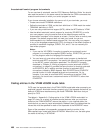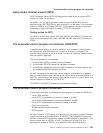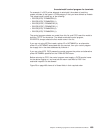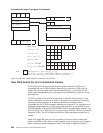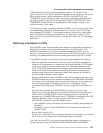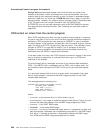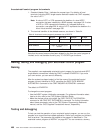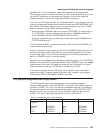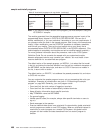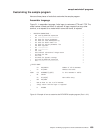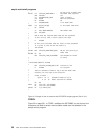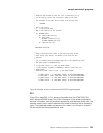Using a table has two disadvantages, each of which loses you some of the
benefits of autoinstall: it takes up storage and it must be maintained. You could
create a table in main temporary storage, so that it is placed in extended storage,
above the 16MB line. You could use a VSAM file rather than a table, to avoid the
storage problem. However, this might be slower, because of the I/O associated with
a file. The table or file can contain information such as PRINTER and
ALTPRINTER, and you can add information such as AUTINSTNAME for devices
that need particular autoinstall models. (See “Selecting the autoinstall model” on
page 492.)
CICS action on return from the control program
When CICS receives control back from the autoinstall control program, it examines
the return code field. If this is zero, and if the other required information supplied is
satisfactory, CICS schedules the new resource for OPNDST in order to complete
the logon request. If the installation process fails, then the control program is driven
again, as though a DELETE had occurred. (See the section “The autoinstall control
program at DELETE” on page 495 for details.) This is necessary to allow the
program to free any allocations (for example, terminal identifiers) made on the
assumption that this INSTALL request would succeed.
If the return code is not zero, then CICS rejects the connection request in the same
way as it rejects an attempt by an unknown terminal to log on to CICS when
autoinstall is not enabled.
For all autoinstall activity, messages are written to the transient data destination
CADL. If an INSTALL fails, a message is sent to CADL, with a reason code. You
can therefore check the output from CADL to find out why an autoinstall request
failed.
If an autoinstall attempt fails for lack of an exact match, then details of the “best
failure” match between a model and the BIND image are written to the CADL
transient data destination.
The message takes the following form:
DFHZC6987 BEST FAILURE FOR NETNAME: nnnnnnnn,
WAS MODEL_NAME: mmmmmmmm,
CINIT BIND: cccccccc...,
MODEL BIND: bbbbbbbb...,
MISMATCH BITS: xxxxxxxx...
where
v ‘nnnnnnnn’ is the netname of the LU which failed to log on.
v ‘mmmmmmmm’ is the name of model that gave the best failure. (That is, the one
that had the fewest bits different from the BIND image supplied by VTAM.)
v ‘cccccccc...’ is the CINIT BIND image.
v ‘bbbbbbbb...’ is the model BIND image.
v ‘xxxxxxxx...’ is a string of hexadecimal digits, where ‘xx’ represents one byte, and
each byte position represents the corresponding byte position in the BIND image.
A bit set to ‘1’ indicates a mismatch in that position between the BIND image
from VTAM and the BIND image associated with the model.
the autoinstall control program for terminals
494
CICS TS for OS/390: CICS Customization Guide



